Running a growing business often feels like juggling a hundred different priorities while putting out fires. If your team seems to be rowing in different directions and you can’t break through to the next level, EOS (Entrepreneurial Operating System) might be exactly what you need.
The Entrepreneurial Operating System (EOS) is a complete business framework that helps entrepreneurs run better companies through six key components: Vision, People, Data, Issues, Process, and Traction. Created by Gino Wickman and laid out in the book Traction, EOS has helped over 100,000 businesses worldwide gain clarity, alignment, and execution discipline.
We’re going to walk you through exactly what EOS is, how it works, and whether it’s right for your business. This isn’t theory from consultants—we run our own business on EOS, and we built Strety because we lived through the challenges of implementing this system.
What Is EOS (The Entrepreneurial Operating System)?
EOS is a complete business operating system that helps entrepreneurs run better companies through six key components: Vision, People, Data, Issues, Process, and Traction. Think of it as the operating system for your business—just like Windows or macOS runs your computer, EOS runs your company.
Created by Gino Wickman in his book Traction: Get a Grip on Your Business, EOS emerged from real-world experience turning around struggling companies. Wickman was an entrepreneur who had to save his family business and then spent years helping other operators do the same. What he discovered was that all business problems fall into six categories, and when you strengthen these six components systematically, everything else starts to fall into place.
Today, over 280,000 businesses run on EOS, according to EOS Worldwide. The system works best for organizations of 10+ employees who are growth-oriented and open to change.
The Core Problem EOS Solves
Here’s the reality: you can’t have 50 people doing everything 50 different ways with 50 different goals in mind. When everyone in your organization sets their own priorities, runs meetings differently, and uses different terminology, you create mass chaos.
Most business operators wrestle with what feels like 136 different issues at any given time. Without a framework to organize all that complexity, you end up with:
- Teams rowing in different directions
- Endless meetings that solve nothing
- Accountability gaps where important work falls through
- Constant firefighting instead of proactive planning
- Inability to scale beyond your current ceiling
EOS cuts through this complexity by giving you one unified system everyone follows. A team of average people running on one unified operating system will outperform a team of high achievers each doing their own thing, every single time.
The Six Key Components of EOS
EOS organizes every aspect of your business into six key components. When you strengthen all six areas, your company becomes significantly more effective. Let’s break down each component and what it means in practice.
[Image: Vision/Traction Organizer (V/TO) template example]
1. Vision Component
The Vision Component gets everyone in your organization 100% on the same page about where you’re going and how you plan to get there. To create your V/TO, answer eight specific questions that clarify your direction:
- Core Values: The 3-5 values that define who you are and how you operate
- Core Focus: Your purpose and niche—what you’re best at
- 10-Year Target: Your long-term vision for the business
- Marketing Strategy: Your target market and what makes you unique
- 3-Year Picture: Where you’ll be three years from now
- 1-Year Plan: Specific revenue, profit, and measurable goals for this year
- Rocks: The 3-7 most important priorities for the next 90 days
- Issues List: Problems that need to be solved
The primary EOS tool here is the Vision/Traction Organizer (V/TO), which documents all these answers on a single two-page document. When done right, anyone in your organization can explain where you’re headed and why it matters. It’s your business mission and vision rolled into one clear, concise document.
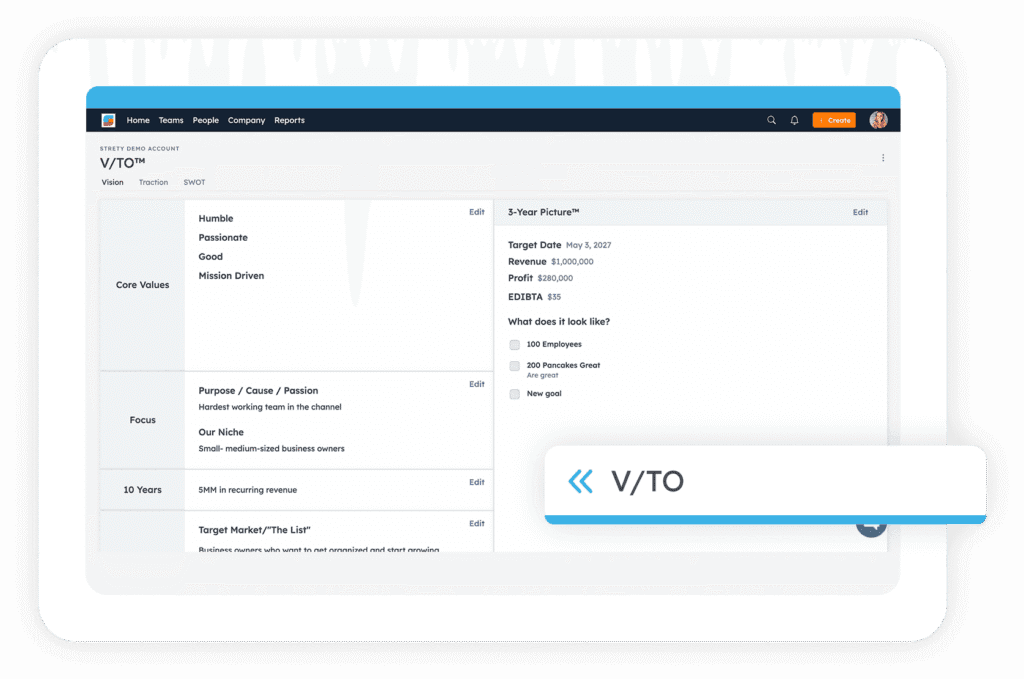
2. People Component
You can’t achieve a great vision without great people. The People Component focuses on two critical concepts: Right People and Right Seats.
Right People means everyone shares your core values. You assess this using a People Analyzer tool that evaluates whether each team member truly embodies your values. If someone’s talented but doesn’t fit your culture, they’re not the right person—and that misalignment will cause problems no matter how skilled they are.
Right Seats means each person has a clearly defined role with specific responsibilities, and they have three things:
- Get it: They understand the role
- Want it: They genuinely desire to do this work
- Capacity to do it: They have the ability to perform at the level needed
The Accountability Chart replaces traditional org charts by focusing on functions and responsibilities rather than just titles and reporting lines. Each seat has 5-7 clear roles, so there’s no confusion about who’s responsible for what.
When Harry from ITeam implemented EOS, he saw immediate benefits: “EOS takes away biases and assumptions. You’re dealing more with data points, dealing with right people in right seats. It literally transformed our business.”
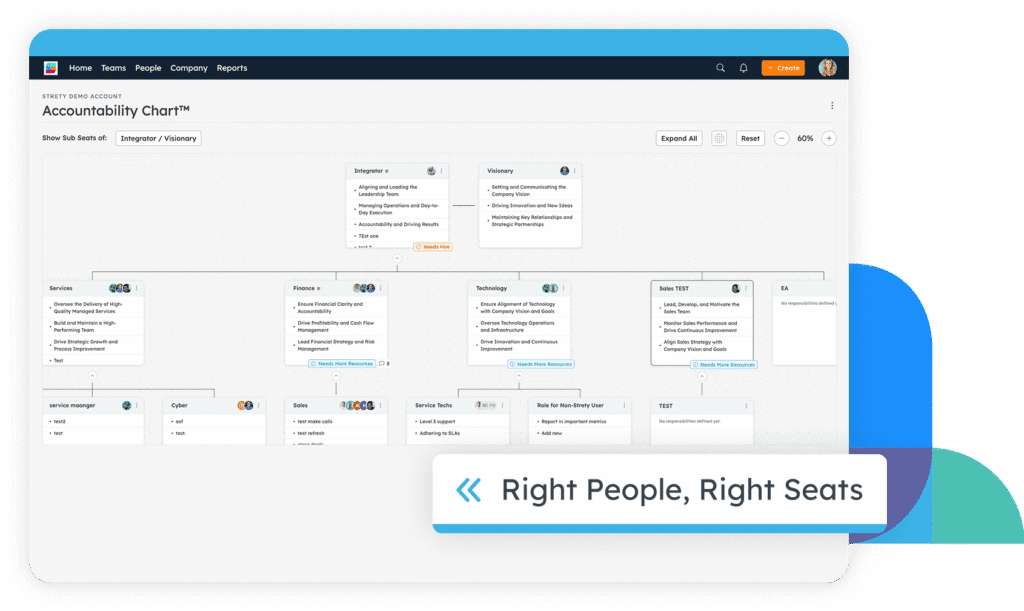
3. Data Component
The Data Component removes gut feelings and opinions from decision-making by focusing on objective numbers. Instead of arguing about whether something’s working, you look at the data.
Every EOS company creates a Scorecard with 5-15 numbers that get reviewed weekly. These aren’t vanity metrics — they’re the specific numbers that predict your success. For a service company, this might include new leads, proposal conversion rate, project completion percentage, customer satisfaction scores, and cash position.
Each seat in your organization also has Measurables — specific numbers that person owns. Your sales leader might own monthly revenue, your operations manager owns on-time delivery percentage, your customer success lead owns retention rate.
This weekly pulse on numbers helps you spot issues before they become crises. When a number goes red, you know exactly where to focus attention.
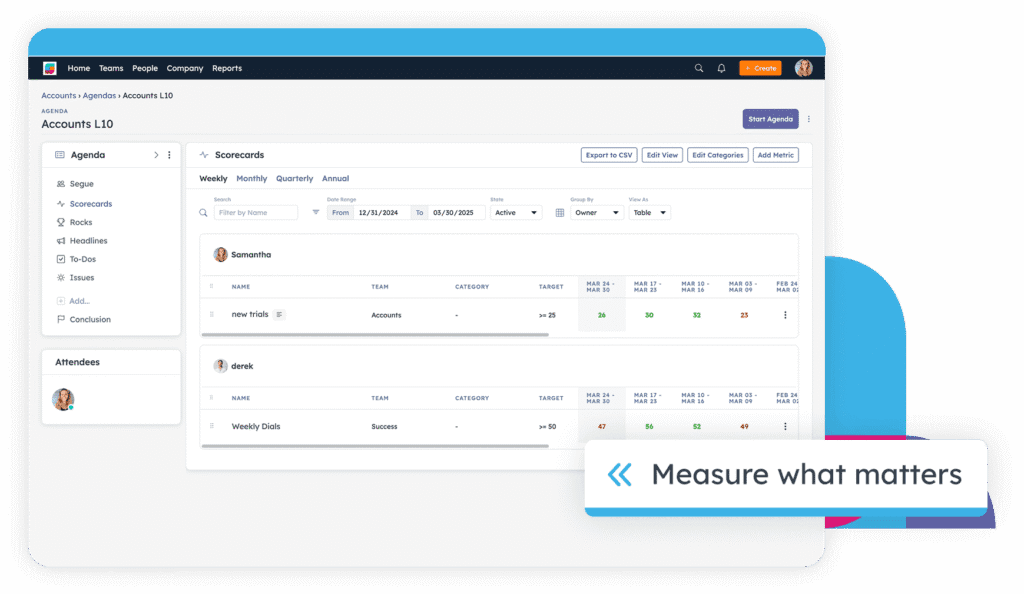
4. Issues Component
Issues are inevitable in business. The question is whether you solve them systematically or let them fester.
EOS uses a structured approach called IDS: Identify, Discuss, Solve. Instead of talking in circles about problems, you:
- Identify the real issue (often what you first discuss isn’t the root problem)
- Discuss it openly until everyone understands the situation
- Solve it with a clear action item, owner, and due date
You maintain an Issues List of problems that need solving, and you tackle them in order of priority. The goal of the Issue Solving Track is to solve issues permanently, not just put band-aids on symptoms.
5. Process Component
The Process Component creates consistency and scalability by documenting how your business actually operates. Most businesses have core processes that happen repeatedly — sales process, project delivery, customer onboarding, billing, hiring — but these processes live in people’s heads rather than being documented.
EOS companies identify their 6-10 core processes and document them at a high level (the 20% that produces 80% of results). This doesn’t mean creating 500-page procedure manuals. It means capturing the essential steps so anyone can follow your proven approach.
When you document processes, you can:
- Train new employees faster
- Ensure consistent quality
- Identify bottlenecks and improvement opportunities
- Scale your business without chaos
- Reduce dependence on any single person
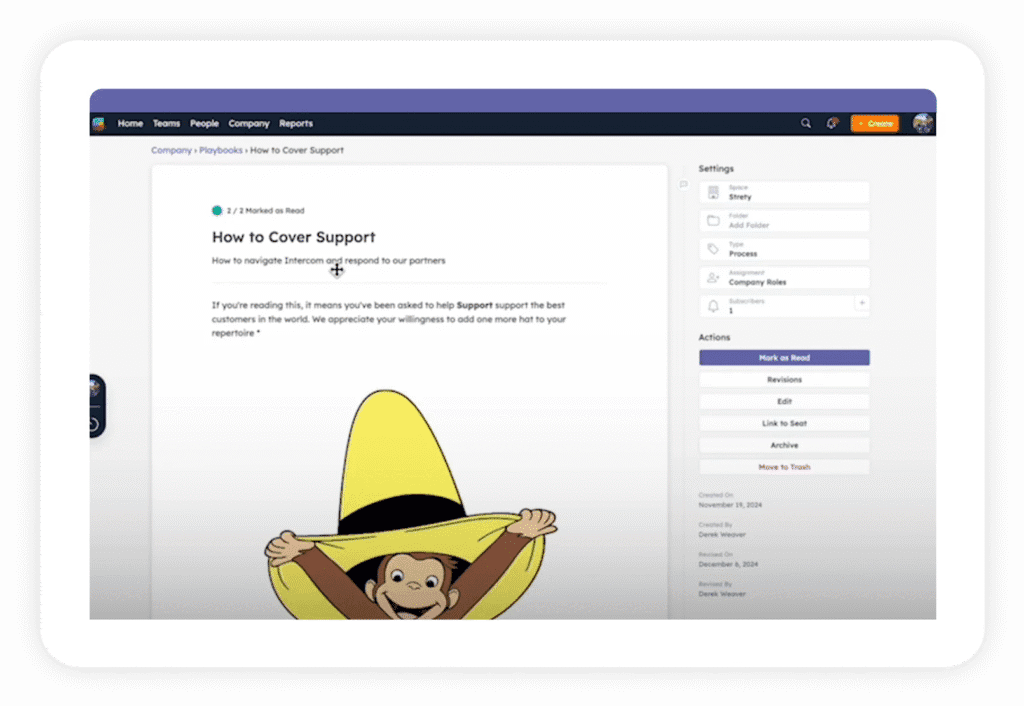
6. Traction Component
Traction is where vision meets execution. This component brings discipline and accountability to your organization so you actually get things done.
The two primary tools are Rocks and the Meeting Pulse.
Rocks are your 3-7 most important priorities for the next 90 days. These are the projects and goals that will move your business forward. The name comes from a story about prioritization: if you fill a jar with sand first, you can’t fit the big rocks. But if you put the big rocks in first, the sand fills in around them. Your Rocks are the big priorities that matter most.
The Meeting Pulse establishes a rhythm of regular meetings:
- Weekly Level 10 Meetings (90 minutes) with each team
- Quarterly planning sessions to set Rocks and review the V/TO
- Annual planning sessions to update your vision
The Level 10 Meeting has a specific agenda that keeps everyone aligned and solves issues quickly. These meetings are called Level 10s because the goal is for everyone to rate them 10 out of 10—they’re that effective and valuable.
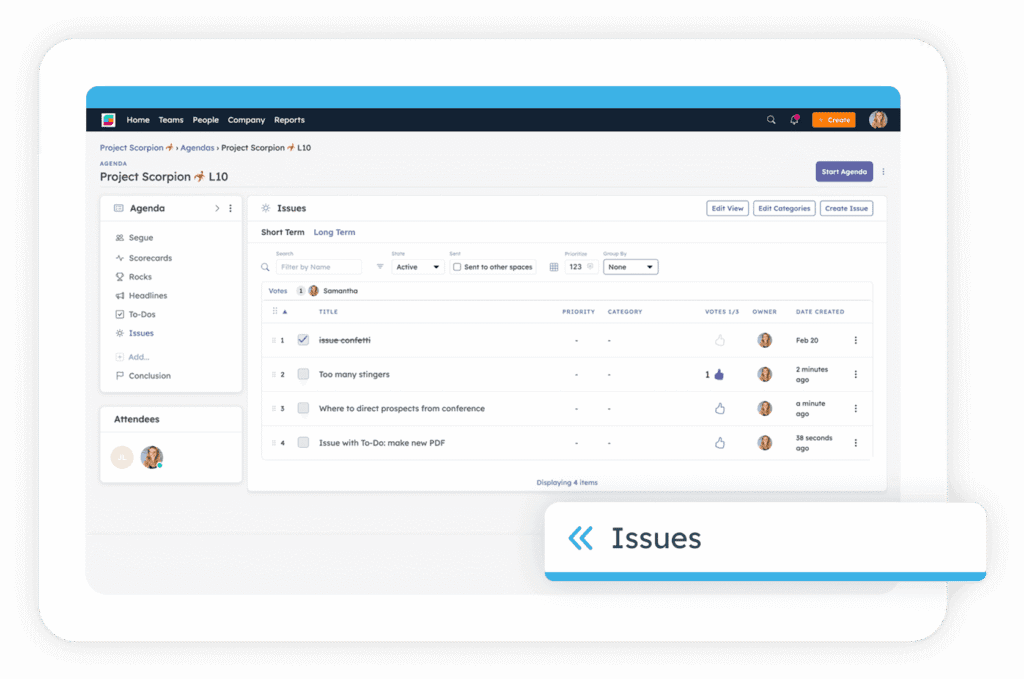
How EOS Actually Works in Practice
Implementing EOS is a journey, not a one-time project. Full implementation typically takes 18-24 months to achieve mastery of all tools and processes, though you’ll start seeing benefits much sooner.
Here’s what the process typically looks like:
First 90 Days: You focus on Vision and People components. The leadership team completes the V/TO, establishes core values, and gets clear on organizational structure. You begin weekly Level 10 Meetings and set your first Rocks. Initial benefits appear quickly as teams gain clarity about priorities.
Months 4-12: You strengthen the Data, Issues, and Process components. You build your Scorecard, establish the IDS methodology for problem-solving, and begin documenting core processes. The meeting rhythm becomes habitual.
Months 13-24: All six components are running consistently. You’re refining your approach, coaching team members on proper EOS usage, and seeing compound benefits from the discipline and alignment.
The key is consistency. You can’t implement EOS for a quarter, see some results, then stop doing it. The system works when it becomes how your business operates, not something extra you do occasionally.
Most companies choose between two implementation paths:
- Working with an EOS Implementer: A certified professional guides you through the process over two years, typically meeting quarterly for full-day sessions. This costs $18,000-$50,000+ annually but ensures pure implementation.
- Self-implementation: You read Traction and other EOS books, then implement the tools yourself. This is less expensive but requires more discipline and may take longer to see results.
Regardless of which path you choose, you’ll need tools to run EOS effectively. Some companies start with spreadsheets and EOS Google Doc templates, but this approach quickly becomes cumbersome as you scale.
Who Should Use EOS?
EOS works best for specific types of organizations. Let’s be honest about when it’s a good fit and when it might not be.
Ideal candidates for EOS:
- Company size: 10-250 employees (the “messy middle” where you’re too big for informal systems but not large enough for enterprise complexity)
- Growth-oriented: You want to scale systematically, not just maintain current operations
- Open to change: Your leadership team is willing to learn new approaches and admit weaknesses
- Entrepreneurial: You’re privately held and make decisions quickly rather than through bureaucratic layers
- Multiple departments: You have distinct functions (sales, operations, finance, etc.) that need coordination
- Leadership commitment: Your top leaders are willing to invest time in quarterly sessions and weekly meetings
Industries where EOS thrives:
- Professional services (marketing agencies, consulting firms, law practices)
- Technology and software companies
- Manufacturing and distribution
- Construction and contracting
- Healthcare practices
- Managed service providers (MSPs) and IT companies
- Accounting firms
Signs you’re ready for EOS:
- You feel like you’ve hit a ceiling and can’t break through
- Different departments seem to work against each other
- You’re frustrated by lack of accountability
- Meetings waste time without resolving issues
- You can’t seem to get everyone on the same page
- You’re tired of being the only person who cares about the vision
When EOS might not be the right fit:
- You’re a solopreneur (EOS is built for teams)
- You’re not actually committed to implementing it consistently (it’s not a magic bullet)
- Your leadership team won’t be vulnerable and honest with each other
- You want a loose, highly unstructured culture (EOS requires discipline)
The Benefits of Implementing EOS
When EOS is implemented well, the benefits compound over time. Here’s what businesses typically experience:
Clarity and alignment: Everyone understands where the company is going and their role in getting there. You stop wasting energy on misalignment and start moving in unison. As Harry from ITeam explained: “Everyone’s talking the same language. Communication, goals, rocks—everything is consistent and we’re all on the same page. Speaking the same language is huge.”
Better accountability: With clear seats, measurables, and Rocks, there’s no ambiguity about who’s responsible for what. People can’t hide or point fingers—the numbers tell the truth.
Improved execution: The 90-day Rock rhythm keeps you focused on what matters most. You stop chasing every shiny object and start completing important projects. Most EOS companies achieve 80%+ Rock completion rates each quarter.
Systematic problem-solving: The IDS process gets issues solved permanently rather than recycled. Your meetings become productive instead of frustrating.
Stronger team health: When everyone shares core values and uses the same system, trust increases. The Level 10 Meeting format encourages honest communication and resolves tensions before they explode.
Scalable processes: Documented processes let you grow without chaos. You can bring in new team members and get them up to speed quickly because everything isn’t locked in someone’s head.
Data-driven decisions: The Scorecard removes emotion from conversations. You discuss facts rather than opinions, which leads to better strategic choices.
Time savings: While EOS requires consistent time investment (weekly meetings, quarterly sessions), it eliminates far more time wasted on miscommunication, rework, and firefighting. As one CEO noted: “We’re getting more done and communicating more effectively with our employees. We make a lot fewer mistakes.”
Check out our case studies for stories of businesses like yours thriving on EOS.
Common EOS Implementation Challenges
Let’s be realistic about the EOS implementation challenges you’ll face. EOS may be simple, but it isn’t easy—if it were, every business would already be doing it.
Initial time investment: Implementing EOS requires significant leadership time, especially in the first year. Quarterly full-day sessions, weekly 90-minute meetings, and time spent documenting processes adds up. Many entrepreneurs resist this because they’re already stretched thin. But the alternative—continuing to operate in chaos—wastes far more time long-term.
Cultural shift required: EOS demands openness, accountability, discipline, and authentic leadership. If your culture has been loose and informal, or if you’ve avoided difficult conversations, the transition will be uncomfortable. People have to get used to being held accountable for numbers and commitments.
Learning new terminology: The EOS framework has specific language—V/TO, Rocks, Level 10s, Accountability Chart, IDS. Some people resist learning new terminology when old terms seemed fine. But the common language is part of what makes EOS work—everyone speaks the same dialect.
Resistance to change: Some team members will push back against new systems and processes. They liked the old way, or they’re afraid the new transparency will expose their weaknesses. This resistance needs to be addressed directly, and sometimes it reveals that people aren’t the right fit for your seats.
Right people, right seats challenges: One of the hardest parts of EOS is honestly assessing whether people fit your core values and seats. You may discover that long-term employees or even friends and family aren’t the right people or aren’t in the right seats. Making those changes requires courage but is essential for success.
Maintaining discipline long-term: It’s easy to be excited about EOS in the beginning. The challenge is maintaining the discipline after the novelty wears off—still doing Level 10s when things get busy, still setting and tracking Rocks every quarter, still using IDS for problem-solving. As Gino Wickman says in Traction: “Stay the course. Mastery requires total commitment.”
Integration with existing systems: Many businesses struggle to connect EOS with their existing tech stack. When your CRM, project management tool, financial software, and EOS tracking are all separate, you end up with double data entry and disconnected information. This is why we built Strety—to integrate EOS with the tools operators actually use.
EOS Software vs. Manual Implementation
When you start implementing EOS, you need tools to track your V/TO, Rocks, Issues Lists, Scorecard numbers, meeting agendas, and accountability charts. You basically have three options:
Spreadsheets and documents: Many companies start here—Google Docs for the V/TO, Excel for the Scorecard, email for meeting notes, etc. It is actually not a bad way to start, so you can start visualizing the framework in action risk-free. We’ve developed a free guide to self-implement EOS here.
This works for a while, but quickly becomes unwieldy. You have information scattered across multiple files, no single source of truth, and everything requires manual updates. Finding information from three quarters ago means digging through old files.
Generic project management tools: Some companies try to force tools like Asana, Monday.com, or Notion to work for EOS. While these are powerful platforms, they weren’t designed for the EOS framework and require extensive customization to match EOS workflows.
Dedicated EOS software: Platforms like Strety are built specifically to run EOS. Everything lives in one place—your vision, people data, numbers, issues, meeting notes, and processes. Most importantly, Strety can integrate with your other business systems to eliminate double data entry.
The right choice depends on your company size and tech sophistication, but here’s what we’ve learned from our own experience:
Manual tracking works fine when you have 10-15 people and a simple structure. Once you grow beyond that, the administrative burden becomes significant. Someone has to compile Scorecard numbers from multiple sources, update the Issues List, track Rock completion, and prepare for meetings. This takes hours every week.
Good EOS software eliminates this overhead. When your To Dos sync with your PSA of choice, when issues can be added from anywhere and populate the right meeting agenda, when you can create an Item from a chat or an email—you get time back to actually run your business.
Harry from ITeam experienced this transition firsthand: “The Microsoft Teams integration is huge for us. Plus the support is spectacular—I can go on the chat and have someone talking to me within about a minute.” The seamless integration meant his team could use EOS directly in the platform they were already working in daily.
The key differentiator is integration capability. If your EOS software sits as an island separate from your other systems, you’ll still face double entry and disconnected data. Look for platforms that integrate with your CRM, project management tools, communication systems, and financial software. This is why unlike Ninety.io, Strety was built with integration at its core—we experienced the pain of manual tracking and disconnected systems when we were implementing EOS in our own business.
Getting Started with EOS
If you’re interested in implementing EOS, here’s a practical roadmap:
Step 1: Read Traction Start with Gino Wickman’s book Traction: Get a Grip on Your Business. This is the foundational text that explains EOS comprehensively. Read it yourself first, then have your leadership team read it so everyone’s on the same page.
Step 2: Assess your current state Evaluate where your business stands in each of the six key components. Most companies are operating at about 20% strength across the board. Identify your biggest pain points—maybe you have clear vision but weak accountability, or strong processes but poor team alignment.
Step 3: Build leadership team buy-in EOS only works when your leadership team commits to it. Schedule a meeting to discuss what you learned from Traction and whether the system resonates. Address concerns and resistance honestly. If your leadership team isn’t aligned on implementing EOS, wait until they are.
Step 4: Choose your implementation approach Decide whether to work with an EOS Implementer or self-implement. Both approaches can work, but they require different commitments. An Implementer brings expertise and accountability; self-implementation demands more discipline but costs less. Learn more about how to choose an EOS Implementer here.
Step 5: Start with Vision Your first major work is completing the Vision/Traction Organizer. Block out time for your leadership team to answer the eight questions together. This typically takes one or two full-day sessions. Don’t rush it—the clarity you gain here sets the foundation for everything else.
Step 6: Launch Level 10 Meetings Begin weekly 90-minute Level 10 Meetings with your leadership team. Use the structured agenda and commit to the timing. The first few will feel awkward as you learn the format, but they’ll quickly become the most valuable meeting of your week.
Step 7: Set your first Rocks Based on your 1-Year Plan, establish the 3-7 most important priorities for the next 90 days. Make sure each Rock has a clear owner and specific deliverable. Review Rock progress in every Level 10 Meeting.
Step 8: Choose your tools Decide how you’ll track EOS—spreadsheets, dedicated software, or a hybrid approach. If you’re serious about EOS long-term, we recommend starting with proper software from the beginning. The time you save on administration pays for the investment quickly.
Step 9: Expect the 90-day test Around day 90 of implementing EOS, many companies hit a wall. The initial excitement fades, the work feels hard, and you question whether it’s worth it. This is normal. Push through. The real benefits come when EOS becomes habitual, not just a new initiative.
Step 10: Iterate and improve EOS is a journey, not a destination. Each quarter, you’ll get better at using the tools. Each year, the six components will be stronger. Stay committed to the process, be patient with yourself and your team, and trust that consistency pays off.
Why Operators Choose Strety for EOS software
We built Strety because we lived through the frustrations of implementing EOS manually. As operators running our own business on EOS, we experienced firsthand the challenges of disconnected systems, double data entry, and administrative overhead that came with trying to track everything in spreadsheets.
When we looked at existing EOS software options, we found they either lacked deep integrations with the tools we already used, had clunky interfaces that teams resisted adopting, or were built by people who didn’t have deep software experience.
Strety is different because we built it from an operator’s perspective:
Deep integrations eliminate double data entry: Connect your To Dos to your other tools, create Issues, Headlines, and To Dos directly from chat and email, and connect existing documentation in Strety Playbooks.
Superior design and ease of use: We obsessed over user experience because we knew that if the tool was frustrating, teams wouldn’t use it.
Built for Microsoft Teams and Slack: Run EOS directly in the communication platforms your team already uses daily. No switching between multiple tools or losing context.
Support from people who get it: When you need help, you’re talking to people who actually run businesses on EOS. We understand your questions because we’ve asked them ourselves.
Scales with your entire organization: Start with your leadership team, then expand to department heads, then to all employees. Everyone can participate in the EOS process, not just a limited number of seats.
If you’re evaluating EOS for your business, we’d love to show you how Strety can make implementation smoother and more effective. Start your free trial or book a demo with our team to see the platform in action.
Transform Your Business with EOS
The Entrepreneurial Operating System has helped over 100,000 businesses worldwide gain clarity, alignment, and traction. It’s not a magic bullet—it requires commitment, discipline, and consistent execution. But for growth-oriented operators tired of feeling overwhelmed and misaligned, EOS provides a proven path forward.
The six key components—Vision, People, Data, Issues, Process, and Traction—work together as an integrated system. When you strengthen all six areas, your business transforms from chaotic to coordinated, from reactive to proactive, from stuck to scaling.
As James from ITeam put it: “If you want to supercharge your business and are having difficulty getting everyone on the same page from a leadership perspective, implementing EOS is the process for you.”
The question isn’t whether EOS works—the track record proves it does. The question is whether you’re ready to commit to implementing it consistently in your business.
If you are, start with Traction, align your leadership team, and choose the tools that will make implementation sustainable. The journey takes 18-24 months, but the benefits compound for years beyond that.
We’re rooting for you. Every entrepreneur deserves to run a business that serves their vision instead of having their business run them them. EOS provides the framework—now it’s up to you to take the first step.
Ready to implement EOS with the right tools? Explore Strety’s platform built by operators for operators, or read more about how EOS implementation works in practice.
Want to learn more about how Strety supports business operating systems? Check out our complete guide to Strety or read about why we built the best EOS software for small businesses.
